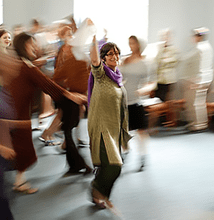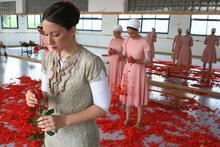Gertrud Kraus
Gertrud Kraus was a pioneer dancer and choreographer who created in the style of expressionist dance. Her career began in Vienna during the 1920s, and she performed her solo and group recitals throughout Central Europe, becoming a prominent modern dance artist. In 1935, at the peak of her European career, she immigrated to Palestine, opened a studio, founded a dance group, and performed extensively, creating a rich new repertoire. A vital motivation of her work lay in the search for a local, Hebraic, dance form. She applied an experimental approach while creating innovative dance forms in search of genuine expressions of the local culture, life, and national aspirations of the Jews. Kraus was the leading figure of early Israeli dance, and in 1968 she received the prestigious Israel Prize.
Family and Education
Gertrud Kraus, the “first lady” of modern expressionistic dance in Israel, was born in Vienna on May 5, 1901. Her father, Leopold Kraus, was born in Bernatice, Bohemia, in 1870, and married her mother, Olga (née Neubauer; born c. 1876), in Prague in 1899. The couple had four children, all born in Vienna: Robert (1900), Gertrud (1901), Margarethe (1902), and Kurt (1903).
Gertrud Kraus studied piano at the State Academy in Vienna, but after graduating she decided upon dance as her true area of artistic creativity. Consequently, she re-enrolled at the State Academy, this time in the modern dance department, which, surprisingly, already existed as early as 1921, under the direction of Gertrud Bodenwieser. After graduating once more, Kraus joined Bodenwieser’s dance company as a dancer.
Striking Out on Her Own
A few months later Kraus decided to strike out on her own. Following the accepted mode of modern dance work at the time, she opened a studio and began creating and rehearsing solo pieces for her own performances. She hired a large and prestigious hall for her first independent recital, and when friends tried to warn her of the risk involved, her response was: “If it’s going to be a flop, at least it will be a spectacular one!”
Kraus’s recital, however, was a huge success, establishing her as a leading modern dancer not only in Austria but also throughout Central Europe. Some of her solo dances, such as The Strange Guest, Vodka, and Guignol, became the basis of her repertoire, which she performed until the mid-1930s throughout Europe and later also in Palestine/Israel, where she lived from 1935 until her death in 1977.
Kraus’s style was what in the 1920s was called “expressionistic dance,” or even “German Dance.” Based on self-expression, the technique was individual and created by each dancer according to his/her artistic vision.
In 1929, Gertrud Kraus became chief assistant to Rudolf von Laban, who was in charge of the annual parade of the trade unions—a political manifestation, with dance and music, held in Vienna on Labor Day, May 1.
International Acclaim
Kraus and her group became internationally acclaimed when she and her dancers performed at an international dance congress held in Munich, Germany, in 1930, in which all the prominent artists of modern dance (including Rudolf von Laban, Mary Wigman, and Ted Shawn) participated. Gertrud Kraus presented her cycle Ghetto Songs (music by Joseph Achron), which in its own way, in that time and place, was a kind of political statement.
In 1931 an impresario invited Kraus to perform in what was then Mandatory Palestine. Her tour was an immense success and she gave performances around the country in cities and agricultural settlements (A voluntary collective community, mainly agricultural, in which there is no private wealth and which is responsible for all the needs of its members and their families.kibbutzim). This visit to Eretz Israel (the Land of Israel) had a profound effect on her and in 1934 she completed another highly successful tour. This time she performed her solo recital Figures and Visions, first in Cairo (Egypt) and then throughout Eretz Israel.
In 1933 Kraus’s company performed her group-work Die Stadt wartet (The City Waits), presenting the modern metropolis as a fascinating place, fraught with danger. Based on a short story by Maxim Gorki, the dance depicted the journey of a youth arriving in a modern city and discovering its social ills and injustices, while at the end expressing the hope of the poor people for an egalitarian society. The heavy irony here was that Hitler was elected Chancellor of Germany while Kraus and her dancers were performing this socialist dance-theater piece on the open-air stage in the garden of the Burgtheater—the most prestigious state theater in the city.
Both as a person and as an artist, Kraus was very much involved in social and political issues. She was an active socialist in Vienna, and even her national vision, which led her to immigrate to Eretz Israel in 1935, drew from her socialist creed. Both her national sentiments and her socialism were an expression of moral issues and of ways to bring humanity nearer to the ideals of freedom and justice.
Immigration to Israel
Upon arriving in Tel Aviv in March 1935, Kraus opened a dance studio, and in November of that year her students participated in her first recital created in Palestine, titled, “Dance Recital—Gertrud Kraus with her Dance Group.” This was the first step towards forming a local dance company, one of Kraus’s main aims, and it took several years of training her students before she felt that they had reached the level of professional dancers. Her pedagogical approach included practice performances in front of an audience, in order to gradually construct the dancers’ creative and performative personae. At the above-mentioned recital, the dancers had accompanied her solo dances in the background only; two years later she produced a full evening for the dancers, who performed the solo dances they themselves had created, together with group dances she choreographed. This was an experimental evening, a kind of invitation from Kraus to the audience to be part of the process and to witness how the dancers' skills had progressed: the response was enthusiastic and spectators filled the halls. In 1938 Kraus finally declared her company’s dancers to be of professional standing, and they went on to give highly successful recitals that made them the leading (modern) dance company in the country. A year later she planned a tour with her company to Europe and America, but the outbreak of World War II prevented its realization.
During the war, Kraus was the choreographer of the Eretz Israel Folk Opera and her dancers became its permanent dance company. At that time it was probably the only modern-dance opera ballet in the world. The years with the Folk Opera constituted a highlight for Kraus and her dancers, who performed a rich and varied repertoire of dance works almost every evening throughout the country. Together with dancing in operas, the company also, and primarily, gave dance recitals in which the programs consisted mainly of dance pieces interspersed with musical intervals. Working with an orchestra and music director, mostly with the composer Mark Lavry, within an established setting, gave Kraus creative freedom to realize her artistic visions more effectively. She applied an experimental approach while creating innovative dance forms in search of genuine expressions of the local culture, life, and national aspirations of the Jews. She and her dancers developed in this way into a significant cultural body, and their status contributed greatly to the success of the Folk Opera. When that institution closed in 1947 due to internal conflicts, it led to a significant reduction in the activity of Kraus with her dance company.
Together with her intensive pedagogical work and running the company, Kraus also gave solo recitals in which she performed mainly new pieces inspired by the changes in her life, particularly her new location in the Middle East and the national yearning for a Jewish homeland. The central theme of these works was “Palestine Landscape Impressions,” a recurrent topic in her solo recitals, expressing her complex experiences as a newcomer in a country that was to become her new homeland. While her work frequently manifested conflicts between the personal and the national, the experiential and the ideological, Kraus was also passionate in participating in the pioneering project of creating a national culture and identity. Indeed, a vital motivation of her work lay in the search for a local, Hebraic, dance form; she experimented with new dance forms and expressions, largely by juxtaposing an expressionist dance style with local, eastern rhythms and movement patterns.
With the establishment of the State of Israel in 1948, Kraus sought to create a publicly run company. She founded a new company, The Israel Ballet Theatre, and presented a petition for public support, with a detailed plan for the institutional and artistic management of this company and a dance school affiliated with it and explaining the national importance of such institutions. No support arrived, however, and she was able to run the company for only two years (1951-1952). During those two years, Kraus sought to invigorate and update local dance practices by combining the expressionist style, which prevailed in the country, with American technique-based methods. With this in mind, she invited African American dancer and choreographer Talley Beatty to run a workshop for dancers and to create a new piece with her company. Although the project was a success and indeed offered new potential, it did not develop further due to lack of funding. In fact, after this project, no new works were created with the company; although Kraus continued to work with her dancers, creating choreographies for theater, operettas, and musicals, she effectively no longer ran a dance company.
In 1948 the Brandeis Camp Institute invited Kraus to give a dance course at its summer camp in Los Angeles, culminating in a festive performance of dance and music. Kraus choreographed and directed the students in the spirit of the Israeli folk celebrations, creating an elaborate show with fifty dancers and seventy musicians and singers and dancing the solo pieces herself. The work told the story of the Jewish people’s struggle for freedom from ancient Egypt to modern times.
Towards the end of the 1950s Kraus retired from performing, concentrating, until her death in 1977, on teaching as well as on painting and sculpture, while also serving as an adviser to several dance companies in Israel.
In 1968 Kraus received the most prestigious accolade for an Israeli artist – the Israel Prize.
Ingber, Judith Brin. “The Gamin Speaks—An Interview with G.K.” Dance Magazine, March 1976.
Ingber, Judith Brin. “Identity Peddlers and the Influence of Gertrud Kraus.” Congress on Research in Dance Conference Proceedings, 39(S1), 2007: 100-105.
Manor, Giora. The Life and Dance of Gertrud Kraus. Tel Aviv: Hakibbutz Hameuchad Publishing House, 1978.
Manor, Giora (ed.), Gertrud Kraus. Tel Aviv: 1988.
“Gertrud Kraus—20 Years after Her Demise,” Special Supplement, Israel Dance Quarterly, issue no. 12, 1997.








